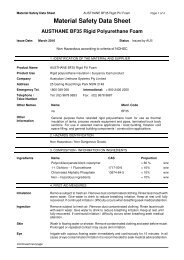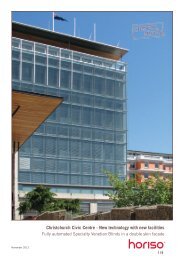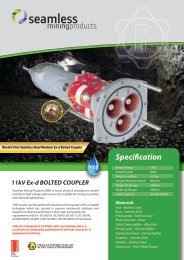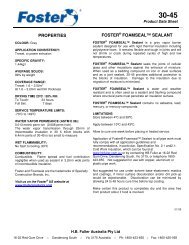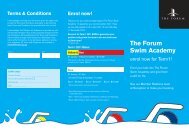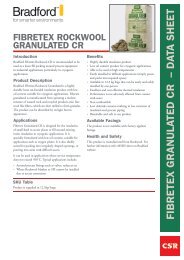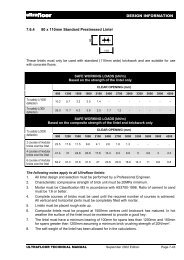Combining energy drinks and alcohol â a recipe for trouble?
Combining energy drinks and alcohol â a recipe for trouble?
Combining energy drinks and alcohol â a recipe for trouble?
Create successful ePaper yourself
Turn your PDF publications into a flip-book with our unique Google optimized e-Paper software.
Adolescent health<br />
<strong>Combining</strong> <strong>energy</strong><br />
Amy Pennay<br />
Dan I Lubman<br />
Peter Miller<br />
<strong>drinks</strong> <strong>and</strong> <strong>alcohol</strong><br />
A <strong>recipe</strong> <strong>for</strong> <strong>trouble</strong>?<br />
Background<br />
<strong>Combining</strong> <strong>energy</strong> <strong>drinks</strong> (such as ‘Red Bull ® ’) with <strong>alcohol</strong><br />
is becoming increasingly popular, particularly among<br />
young people. However, as yet, limited research has been<br />
conducted examining the harms associated with this <strong>for</strong>m<br />
of drinking.<br />
Objective<br />
To review current evidence associated with combining<br />
<strong>energy</strong> <strong>drinks</strong> with <strong>alcohol</strong> <strong>and</strong> provide recommendations<br />
<strong>for</strong> addressing this issue within primary care.<br />
Discussion<br />
<strong>Combining</strong> <strong>alcohol</strong> with <strong>energy</strong> <strong>drinks</strong> can mask the signs<br />
of <strong>alcohol</strong> intoxication, resulting in greater levels of <strong>alcohol</strong><br />
intake, dehydration, more severe <strong>and</strong> prolonged hangovers,<br />
<strong>and</strong> <strong>alcohol</strong> poisoning. It may also increase engagement in<br />
risky behaviours (such as drink driving) as well as <strong>alcohol</strong><br />
related violence. General practitioners should be aware of<br />
the harms associated with this pattern of drinking, <strong>and</strong><br />
provide screening <strong>and</strong> relevant harm reduction advice.<br />
Keywords: carbonated beverages; <strong>alcohol</strong>ic beverages;<br />
adolescent; young adult; caffeine; taurine; guarana;<br />
glucuronolactone<br />
Energy <strong>drinks</strong>, such as ‘Red Bull ® ’ <strong>and</strong> ‘V’, are beverages<br />
that are designed to provide a boost of <strong>energy</strong> or enhance<br />
alertness. 1,2 Red Bull ® was the first <strong>energy</strong> drink to be<br />
released <strong>and</strong> was introduced into Europe in 1987. Since<br />
then, the number of available <strong>energy</strong> <strong>drinks</strong> has increased<br />
to over 500 br<strong>and</strong>s worldwide, 3–5 with sales exceeding<br />
$500 million per annum in the United States of America. 6<br />
What are the ingredients in <strong>energy</strong><br />
<strong>drinks</strong>?<br />
The main ingredients in <strong>energy</strong> <strong>drinks</strong> are caffeine, guarana, taurine<br />
<strong>and</strong> glucuronolactone (Table 1).<br />
Caffeine<br />
Caffeine is a central nervous system stimulant. A st<strong>and</strong>ard 250<br />
mL <strong>energy</strong> drink contains 85 mg of caffeine, which is equivalent<br />
to the amount of caffeine found in an average cup of coffee. 1,4<br />
Alarmingly however, some <strong>energy</strong> <strong>drinks</strong> contain up to 500 mg<br />
of caffeine per serve. 5 It has been suggested that <strong>energy</strong> drink<br />
companies include natural ingredients, such as guarana, yerba<br />
mate <strong>and</strong> coca leaf, to exceed the legal caffeine content limit, 4<br />
which in Australia is 320 mg/L. 7<br />
Guarana<br />
Guarana is a herbal substance extracted from a South American<br />
climbing plant of the maple family, Sapindaceae. It has long been<br />
used by Amazonians to increase alertness <strong>and</strong> <strong>energy</strong>. Guarana<br />
contains around twice the caffeine found in coffee beans. Guarana<br />
is more slowly absorbed into the gastrointestinal tract <strong>and</strong> thus<br />
is said to have a longer lasting effect than caffeine sourced from<br />
coffee beans. 3<br />
Taurine<br />
Taurine is an amino acid which modulates cardiac <strong>and</strong> skeletal<br />
muscle contractility. Taurine is naturally produced in the body, but<br />
nearly all commercially available taurine is chemically synthesised.<br />
There is some evidence that taurine improves brain function <strong>and</strong><br />
104 Reprinted from Australian Family Physician Vol. 40, No. 3, March 2011
Table 1. Ingredients in <strong>energy</strong> <strong>drinks</strong><br />
In a typical 250 mL <strong>energy</strong> drink you will find:<br />
• 80–300 mg caffeine (which may be derived from pure<br />
caffeine, guarana <strong>and</strong>/or other natural sources of<br />
caffeine such as yerba mate)<br />
• Up to 1000 mg taurine<br />
• 60 mg glucuronolactone<br />
• Up to 40 g sugars (glucose/sucrose)<br />
You might also find:<br />
• B group vitamins<br />
• Ginseng (a herb also noted to boost <strong>energy</strong>)<br />
• Ginkgo biloba (a natural ingredient noted to have<br />
antidepressant properties)<br />
• L-Carnitine (an amino acid that helps improve <strong>energy</strong><br />
levels)<br />
• Creatine (a source of protein)<br />
exercise per<strong>for</strong>mance, as well as lowering blood pressure. It is<br />
estimated that the daily intake of taurine in humans is between 40 <strong>and</strong><br />
400 mg. Some <strong>energy</strong> <strong>drinks</strong> contain more than 10 times the average<br />
person’s suggested daily limit of taurine. 3<br />
Glucuronolactone<br />
Glucuronolactone is a naturally occurring metabolite <strong>for</strong>med from<br />
glucose. It is thought to fight fatigue <strong>and</strong> provide a sense of wellbeing.<br />
In some <strong>energy</strong> <strong>drinks</strong>, the amount of glucuronolactone is more than<br />
250 times the amount found in other food sources. 3<br />
What are the health consequences<br />
associated with <strong>energy</strong> <strong>drinks</strong>?<br />
Health problems associated with <strong>energy</strong> <strong>drinks</strong> relate to excessive<br />
caffeine intake, particularly in people consuming more than 200<br />
mg of caffeine daily. Symptoms of excessive caffeine consumption<br />
(or poisoning) include insomnia, nervousness, headache, nausea,<br />
vomiting, tachycardia <strong>and</strong> palpitations. 8 In large amounts, guarana<br />
is associated with many of the same adverse effects as caffeine,<br />
including insomnia, tremors, anxiety, palpitations, urinary frequency<br />
<strong>and</strong> hyperactivity. 3 While taurine <strong>and</strong> glucuronolactone are not<br />
necessarily harmful when consumed alone, there is insufficient data<br />
regarding their potential synergistic effects with one another, or with<br />
caffeine <strong>and</strong> guarana. 3,5,9<br />
Between 2004 <strong>and</strong> 2006, there were 41 reported cases of<br />
adverse reactions from <strong>energy</strong> <strong>drinks</strong> in the USA. Common<br />
symptoms included nausea/vomiting, tachycardia, hypertension,<br />
agitation, tremors, dizziness <strong>and</strong> chest pain. 5 In some cases, <strong>energy</strong><br />
drink consumption has been associated with death. 8 This is most<br />
often in the context of consumption during or after sport. Red Bull ®<br />
was banned in France after the death of an 18 year old male who<br />
died as a result of playing basketball after consuming four cans of<br />
Red Bull ® . Red Bull ® was also banned in Denmark, although the ban<br />
has recently been revoked. 3<br />
Mixing <strong>energy</strong> <strong>drinks</strong> with <strong>alcohol</strong><br />
– a recent trend<br />
There is increasing evidence that a greater proportion of young people<br />
around the world are using <strong>alcohol</strong> in combination with <strong>energy</strong> <strong>drinks</strong>,<br />
particularly in licensed venues. 2,9–11 While <strong>energy</strong> <strong>drinks</strong> are typically<br />
combined with vodka or Jägermeister (known as ‘jagerbombs’), 4,10,12 a<br />
wide range of prepackaged <strong>alcohol</strong>ic <strong>energy</strong> <strong>drinks</strong> have also recently<br />
hit the market.<br />
Studies from Italy <strong>and</strong> the USA show that 25% of university<br />
students report in the past month, consumption of <strong>energy</strong> <strong>drinks</strong> in<br />
combination with <strong>alcohol</strong>. 2,11 In an Italian study, 36% of students<br />
reported using <strong>alcohol</strong> <strong>and</strong> <strong>energy</strong> <strong>drinks</strong> more than three times in the<br />
past month. 11 Prevalence rates among young people in Australia are<br />
unknown, but 69% of regular ecstasy users surveyed as part of the<br />
Ecstasy <strong>and</strong> Related Drugs Reporting System report having previously<br />
combined <strong>alcohol</strong> with <strong>energy</strong> <strong>drinks</strong>. This sample of 756 ecstasy<br />
users from around Australia (with a mean age of 24 years) reported<br />
consuming an average of three <strong>energy</strong> <strong>drinks</strong> in their last session of<br />
use, 13 which exceeds the recommended intake of two <strong>energy</strong> <strong>drinks</strong><br />
per day. 7<br />
Problems associated with mixing<br />
<strong>energy</strong> <strong>drinks</strong> <strong>and</strong> <strong>alcohol</strong><br />
There is a small but growing body of research highlighting the harms<br />
associated with combining <strong>alcohol</strong> <strong>and</strong> <strong>energy</strong> <strong>drinks</strong> (Table 2). 2,3,9,10,14<br />
These studies identify three main harms associated with mixing<br />
<strong>alcohol</strong> <strong>and</strong> <strong>energy</strong> <strong>drinks</strong>:<br />
Table 2. What are the harms of mixing <strong>energy</strong><br />
<strong>drinks</strong> <strong>and</strong> <strong>alcohol</strong>?<br />
Reduced sensitivity to the signs of <strong>alcohol</strong> intoxication,<br />
thereby increasing the likelihood of:<br />
• <strong>alcohol</strong> poisoning<br />
• impaired judgment leading to:<br />
– accidents (eg. stepping in front of traffic)<br />
– poor decision making (eg. driving while intoxicated)<br />
– risky behaviour (eg. risky sexual behaviour, violence)<br />
Dehydration leading to:<br />
• diarrhoea<br />
• nausea/vomiting<br />
• fatigue<br />
• headaches<br />
• increased heart rate<br />
• muscle cramps<br />
• more severe hangover (affecting subsequent work<br />
productivity <strong>and</strong> driving per<strong>for</strong>mance)<br />
Mixed messages to the nervous system resulting<br />
in cardiovascular problems (eg. palpitations) <strong>and</strong><br />
disturbed sleep<br />
Reprinted from Australian Family Physician Vol. 40, No. 3, march 2011 105
FOCUS <strong>Combining</strong> <strong>energy</strong> <strong>drinks</strong> <strong>and</strong> <strong>alcohol</strong> – a <strong>recipe</strong> <strong>for</strong> <strong>trouble</strong>?<br />
• <strong>energy</strong> <strong>drinks</strong> may mask the feeling of <strong>alcohol</strong> intoxication.<br />
This is likely to be associated with the stimulant effects of<br />
caffeine <strong>and</strong> guarana, but also taurine. Data from animal<br />
studies has shown that taurine may mask some of the effects<br />
of <strong>alcohol</strong> <strong>and</strong> possibly encourage greater consumption.<br />
Alcohol has also been noted to have a negative effect on<br />
taurine homeostasis in humans. 3 <strong>Combining</strong> <strong>alcohol</strong> with<br />
<strong>energy</strong> <strong>drinks</strong> may enable greater levels of <strong>alcohol</strong> intake,<br />
which can lead to greater intoxication <strong>and</strong> even <strong>alcohol</strong><br />
poisoning. Furthermore, greater levels of intoxication, but<br />
increased feelings of alertness, can create a false perception<br />
of actual impairment. This may lead to poor decision making<br />
<strong>and</strong> increased levels of risky behaviours, such as drink driving,<br />
sexual risk taking (such as engaging in unsafe sex) <strong>and</strong><br />
violence. 9 Greater <strong>alcohol</strong> consumption is also likely to lead<br />
to more severe <strong>and</strong> prolonged hangovers, which can result in<br />
absenteeism, poor work per<strong>for</strong>mance <strong>and</strong> impaired driving or<br />
operation of machinery 10<br />
• <strong>alcohol</strong> <strong>and</strong> <strong>energy</strong> <strong>drinks</strong> are both diuretics <strong>and</strong> hence<br />
dehydration is more likely. There have been a number of<br />
deaths associated with <strong>energy</strong> drink consumption after<br />
sport as a consequence of dehydration. 3 Given that <strong>alcohol</strong><br />
is likely to further exacerbate levels of dehydration, this<br />
poses a serious concern – particularly if these <strong>drinks</strong> are<br />
being consumed by young people who are dancing <strong>for</strong> long<br />
periods of time. Increased dehydration also has the potential<br />
to exacerbate the effects of a hangover, <strong>and</strong> lead to greater<br />
impairment the day after consumption of these <strong>drinks</strong><br />
• mixing stimulants with depressants sends mixed messages to<br />
the nervous system. High levels of caffeine are likely to raise<br />
one’s heart rate <strong>and</strong> blood pressure, while the depressant<br />
effects of <strong>alcohol</strong> are likely to have the opposite effect. Recent<br />
research among young <strong>alcohol</strong> <strong>and</strong> ‘party drug’ users 15 found<br />
that increased heart rate <strong>and</strong> palpitations were the most<br />
frequently reported adverse effects associated with <strong>alcohol</strong><br />
<strong>and</strong> <strong>energy</strong> drink consumption, along with sleep disturbance.<br />
What don’t we know?<br />
Although limited research examining the prevalence <strong>and</strong> harms<br />
associated with combining <strong>energy</strong> <strong>drinks</strong> with <strong>alcohol</strong> has been<br />
conducted in North America <strong>and</strong> Europe, no such research<br />
is currently available within the Australian context. There<br />
is currently no Australian data available on the relationship<br />
between <strong>energy</strong> <strong>drinks</strong> <strong>and</strong> <strong>alcohol</strong>, nor their potential link<br />
with intoxication, violence, risk taking, lost productivity, injury<br />
<strong>and</strong> hospital attendance. We also do not have any local or<br />
international research available regarding the social <strong>and</strong> cultural<br />
contexts of <strong>energy</strong> drink <strong>and</strong> <strong>alcohol</strong> consumption. Indeed, little<br />
is known about the self perceived benefits of combining these<br />
beverages, nor in what ways, amounts, patterns, frequencies <strong>and</strong><br />
locations they are being used.<br />
Implications <strong>for</strong> primary care<br />
Screening<br />
It is important that general practitioners are aware of the harms<br />
associated with excessive <strong>energy</strong> drink consumption, particularly<br />
when used in combination with <strong>alcohol</strong>. Patients may not be aware<br />
that consuming <strong>energy</strong> <strong>drinks</strong> is associated with any level of risk,<br />
or increase in <strong>alcohol</strong> related harm. Indeed, many young people are<br />
unlikely to know how much caffeine is contained within a st<strong>and</strong>ard<br />
<strong>energy</strong> drink, nor be aware of recommendations regarding safe<br />
levels of daily caffeine consumption or the potential consequences of<br />
consuming high doses of guarana, taurine <strong>and</strong> glucuronolactone. As a<br />
consequence, they may report their level of <strong>alcohol</strong> consumption but<br />
not consider any concurrent <strong>energy</strong> drink use to be relevant to a health<br />
practitioner. It is there<strong>for</strong>e essential to prompt <strong>for</strong> this in<strong>for</strong>mation.<br />
Even among patients who are not presenting with issues relating<br />
to <strong>alcohol</strong> or <strong>energy</strong> drink consumption, any opportunity to enquire<br />
about such habits will be useful. A range of screening tools have<br />
been validated <strong>for</strong> the identification of risky <strong>alcohol</strong> consumption<br />
within primary care settings. The most widely used is the Alcohol Use<br />
Disorders Identification Test (AUDIT), 16 a 12 question screening tool<br />
that can be delivered in less than 5 minutes. Shorter screening options<br />
include the Fast Alcohol Screening Test (FAST), 17 which consists of four<br />
questions, <strong>and</strong> the Single Alcohol Screening Questionnaire (SAS-Q), 18<br />
which has only one question. Adding an additional question to these<br />
screening tools, such as ‘How often do you drink <strong>energy</strong> <strong>drinks</strong> with<br />
<strong>alcohol</strong>?’ might be a useful way of screening <strong>for</strong> this behaviour.<br />
Harm reduction in<strong>for</strong>mation<br />
Any interaction with a young person within the primary care setting<br />
provides an opportunity to raise awareness regarding the potential<br />
harms of combining <strong>energy</strong> <strong>drinks</strong> with <strong>alcohol</strong>, as well as providing<br />
useful harm reduction messages. Relevant harm reduction in<strong>for</strong>mation<br />
includes:<br />
• awareness of the dangers of consuming more than 200 mg caffeine<br />
daily. For this reason, it is recommended that no more than two<br />
st<strong>and</strong>ard <strong>energy</strong> <strong>drinks</strong> are consumed daily (with or without <strong>alcohol</strong>)<br />
• awareness of the masking effects of <strong>energy</strong> <strong>drinks</strong> on <strong>alcohol</strong><br />
intoxication (which may lead to greater <strong>alcohol</strong> consumption <strong>and</strong><br />
poor decision making), including warning against driving even if<br />
they do not feel impaired<br />
• awareness of the risks associated with dehydration (including<br />
nausea, diarrhoea, headaches <strong>and</strong> fatigue)<br />
• awareness of the risks associated with combining stimulants <strong>and</strong><br />
depressants (including mixed messages to the central nervous<br />
system).<br />
Conclusion <strong>and</strong> recommendations<br />
Although limited, there is growing evidence of harms associated<br />
with excessive consumption of <strong>energy</strong> <strong>drinks</strong> (both in isolation <strong>and</strong><br />
in combination with <strong>alcohol</strong>). However, there are currently limited<br />
106 Reprinted from Australian Family Physician Vol. 40, No. 3, March 2011
<strong>Combining</strong> <strong>energy</strong> <strong>drinks</strong> <strong>and</strong> <strong>alcohol</strong> – a <strong>recipe</strong> <strong>for</strong> <strong>trouble</strong>? FOCUS<br />
warnings concerning the harms associated with the combined use<br />
of these beverages on prepackaged <strong>alcohol</strong>ic <strong>energy</strong> <strong>drinks</strong>. Given<br />
the dearth of Australian studies examining <strong>alcohol</strong>ic <strong>energy</strong> drink<br />
consumption, investment in research that explores the patterns <strong>and</strong><br />
harms associated with such use is urgently required.<br />
In this case, it is worth considering a precautionary stance,<br />
recommending that new products combining <strong>alcohol</strong> <strong>and</strong> <strong>energy</strong> <strong>drinks</strong><br />
demonstrate safety at likely consumption levels be<strong>for</strong>e being allowed<br />
onto the market. In the meantime, GPs should discuss <strong>energy</strong> drink<br />
consumption with patients <strong>and</strong> recommend limiting their use (up to two<br />
serves per day).<br />
Summary of important points<br />
• International epidemiological data show that the combination of<br />
<strong>alcohol</strong> with <strong>energy</strong> <strong>drinks</strong> is popular, particularly among young<br />
people.<br />
• Limited Australian research has been conducted examining this<br />
phenomenon.<br />
• Energy <strong>drinks</strong> contain high levels of caffeine, guarana, taurine <strong>and</strong><br />
glucuronolactone.<br />
• The combination of <strong>alcohol</strong> with <strong>energy</strong> <strong>drinks</strong> is likely to increase<br />
the risk of harms associated with consuming either beverage in<br />
isolation.<br />
• It is important to specifically ask patients about their <strong>energy</strong> drink<br />
consumption, particularly in instances where they are presenting<br />
with issues related to <strong>alcohol</strong>.<br />
• GPs are well placed to raise young people’s awareness of the<br />
harms associated with excessive <strong>energy</strong> drink consumption (in<br />
isolation or in combination with <strong>alcohol</strong>).<br />
7. Australia New Zeal<strong>and</strong> Food Authority. Inquiry report. Application A394.<br />
Formulated caffeinated beverages. Canberra: Australia New Zeal<strong>and</strong> Food<br />
Authority, 2001.<br />
8. Clauson KA, Shields KM, McQueen CE, Persad N. Safety issues associated<br />
with commercially available <strong>energy</strong> <strong>drinks</strong>. J Am Pharm Assoc 2008;48:e55–<br />
63.<br />
9. Thombs DL, O’Mara RJ, Tsukamoto M, et al. Event-level analyses of <strong>energy</strong><br />
drink consumption <strong>and</strong> <strong>alcohol</strong> intoxication in bar patrons. Addict Behav<br />
2010;35:325–30.<br />
10. Marczinski CA, Fillmore MT. Clubgoers <strong>and</strong> their trendy cocktails: implications<br />
of mixing caffeine into <strong>alcohol</strong> on in<strong>for</strong>mation processing <strong>and</strong> subjective<br />
reports of intoxication. Exp Clin Psychopharmacol 2006;14:450–8.<br />
11. Oteri A, Salvo F, Caputi AP, Calapai G. Intake of <strong>energy</strong> <strong>drinks</strong> in association<br />
with <strong>alcohol</strong> beverages in a cohort of students of the School of Medicine of<br />
the University of Messina. Alcohol Clin Exp Res 2007;31:1677–80.<br />
12. Jackson M, Hastings G, Wheeler C, Eadie D, Mackintosh A. Marketing<br />
<strong>alcohol</strong> to young people: implications <strong>for</strong> industry regulation <strong>and</strong> research<br />
policy. Addiction 2000;95:597–608.<br />
13. Sindich N, Burns L. Australian trends in ecstasy <strong>and</strong> related drug markets<br />
2009: findings from the Ecstasy <strong>and</strong> Related Drugs Reporting System (EDRS).<br />
Australian Drug Trends Series No. 46. Sydney: National Drug <strong>and</strong> Alcohol<br />
Research Centre, University of New South Wales, 2010.<br />
14. Ferreira SE, Tulio de Mello M, Pompeia S, de Souza-Formigoni ML. Effects<br />
of <strong>energy</strong> drink ingestion on <strong>alcohol</strong> intoxication. Alcohol Clin Exp Res<br />
2006;30:598–605.<br />
15. Pennay A. ‘What goes up must go down’: exploring the harms experienced<br />
by a group of heavy ecstasy users in Melbourne <strong>and</strong> discussing the implications<br />
<strong>for</strong> harm reduction. 3rd International MDMA Conference, June 2010.<br />
Melbourne, Australia.<br />
16. Saunders JB, Aasl<strong>and</strong> OG, Babor TF, De La Fuente JR, Grant M. Development<br />
of the Alcohol Use Disorders Identification Test (AUDIT): WHO Collaborative<br />
Project on Early Detection of Persons with Harmful Alcohol Consumption-II.<br />
Addiction 1993;88:791–804.<br />
17. Hodgson R, Alwyn T, John B, Thom B, Smith A. The FAST <strong>alcohol</strong> screening<br />
test. Alcohol 2002;37:61–6.<br />
18. Canagasaby A, Vinson DC. Screening <strong>for</strong> hazardous or harmful drinking using<br />
one or two quantity-frequency questions. Alcohol 2005;40:208–13.<br />
Authors<br />
Amy Pennay BA(Hons) is Research Fellow, Turning Point Alcohol <strong>and</strong><br />
Drug Centre, Eastern Health <strong>and</strong> Monash University, Melbourne,<br />
Victoria. amy.pennay@turningpoint.org.au<br />
Dan I Lubman BSc(Hons), MBChB, PhD, FRANZCP, FAChAM, is Director<br />
<strong>and</strong> Professor of Addiction Studies, Turning Point Alcohol <strong>and</strong> Drug<br />
Centre, Eastern Health <strong>and</strong> Monash University, Melbourne, Victoria<br />
Peter Miller PhD(Sociology), BA(Hons), is Senior Research Fellow,<br />
School of Psychology, Deakin University, Geelong, Victoria.<br />
Conflict of interest: none declared.<br />
References<br />
1. Miller KE. Energy <strong>drinks</strong>, race, <strong>and</strong> problem behaviours among college students.<br />
J Adolesc Health 2008;43:490–7.<br />
2. O’Brien MC, McCoy TP, Rhodes SD, Wagoner A, Wolfson M. Caffeinated<br />
cocktails: <strong>energy</strong> drink consumption, high-risk drinking, <strong>and</strong> <strong>alcohol</strong>-related<br />
consequences among college students. Acad Emerg Med 2008;15:453–60.<br />
3. Finnegan D. The health effects of stimulant <strong>drinks</strong>. Nutrition Bulletin<br />
2003;28:147–55.<br />
4. Kuhns JB, Clodfelter TA, Bersot HY. Examining <strong>and</strong> underst<strong>and</strong>ing the joint<br />
role of caffeine <strong>and</strong> <strong>alcohol</strong> in facilitating violent offending <strong>and</strong> victimization.<br />
Contemp Drug Probl 2010;37:267–87.<br />
5. Reissig CJ, Strain EC, Griffiths RR. Caffeinated <strong>energy</strong> <strong>drinks</strong> – a growing<br />
problem. Drug Alcohol Depend 2009;99:1–10.<br />
6. Miller KE. Wired: <strong>energy</strong> <strong>drinks</strong>: jock identity, masculine norms, <strong>and</strong> risk<br />
taking. J Am Coll Health 2008;56:481–9.<br />
Reprinted from Australian Family Physician Vol. 40, No. 3, march 2011 107



